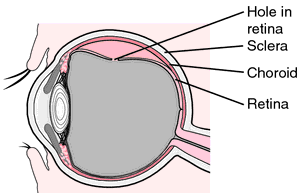Medical term:
detachment
detachment
[de-tach´ment]the condition of being separated or disconnected.
detachment of retina (retinal detachment) separation of the inner layers of the retina from the pigment epithelium, which remains attached to the choroid; it occurs most often as a result of degenerative changes in the peripheral retina and vitreous body, which produce holes or tears in the retina ranging from tiny breaks of less than 0.1 mm to extensive holes extending over the entire fundus. It is most common in persons over 40, and about two thirds of affected patients are myopic (nearsighted). Trauma to the eyeball, severe contusions, inflammatory lesions, and sometimes ocular surgery such as for a cataract can also lead to retinal detachment.
Symptoms. The onset of symptoms may be gradual or sudden, depending on the cause, size, number, and location of retinal holes. The patient usually sees flashes of light and then notices cloudy vision or loss of a portion of the visual field. Another common manifestation is the sensation of spots or moving particles in the field of vision. Treatment should be sought immediately when any of these occur. In severe retinal detachment there can be complete loss of vision.
Treatment. Retinal detachment is corrected surgically. Two outpatient modes of therapy currently in use are photocoagulation, using the light source of an argon laser; and cryosurgery, in which a freezing probe is used to penetrate the tissues of the eye and encircle the hole or tear in the retina. Scar tissue eventually forms and seals the opening.
Scleral buckling is another treatment, which places the retinal breaks in contact with the pigment epithelium and choroid. Adhesions form and bind the sensory retinal layers to these structures. In some cases, such as vitreous hemorrhage, the surgeon performs a combined vitrectomy and humoral retinal repair. The purpose of the surgery is to remove vitreous that is opaque because of accumulated blood, and to stabilize the retina in apposition to the choroid. Aqueous humor eventually fills the space.
Pneumatic retropexy, the most recently developed treatment, consists of injection of air or gas into the posterior vitreous cavity, followed by positioning of the patient so that the bubble rises, presses against the area of torn retina, and pushes it back into its normal position against the choroid. Laser photocoagulation and/or cryopexy is then done to create inflammation within the tissues, resulting in scarring and permanent reattachment of the area(s) of torn retina. This procedure is appropriate for only certain types and locations of retinal detachment.
Preoperative and postoperative care of the patient requires a thorough knowledge of the type of detachment afflicting the patient and the surgical procedure performed. Positioning of the patient and the level of physical activity allowed after surgery are determined by the surgeon. Before discharge from the hospital the patient will need instruction in follow-up care, especially the correct procedure for instilling eye drops.
Scleral buckling is another treatment, which places the retinal breaks in contact with the pigment epithelium and choroid. Adhesions form and bind the sensory retinal layers to these structures. In some cases, such as vitreous hemorrhage, the surgeon performs a combined vitrectomy and humoral retinal repair. The purpose of the surgery is to remove vitreous that is opaque because of accumulated blood, and to stabilize the retina in apposition to the choroid. Aqueous humor eventually fills the space.
Pneumatic retropexy, the most recently developed treatment, consists of injection of air or gas into the posterior vitreous cavity, followed by positioning of the patient so that the bubble rises, presses against the area of torn retina, and pushes it back into its normal position against the choroid. Laser photocoagulation and/or cryopexy is then done to create inflammation within the tissues, resulting in scarring and permanent reattachment of the area(s) of torn retina. This procedure is appropriate for only certain types and locations of retinal detachment.
Preoperative and postoperative care of the patient requires a thorough knowledge of the type of detachment afflicting the patient and the surgical procedure performed. Positioning of the patient and the level of physical activity allowed after surgery are determined by the surgeon. Before discharge from the hospital the patient will need instruction in follow-up care, especially the correct procedure for instilling eye drops.

Retinal detachment. From Frazier et al., 2000.
Miller-Keane Encyclopedia and Dictionary of Medicine, Nursing, and Allied Health, Seventh Edition. © 2003 by Saunders, an imprint of Elsevier, Inc. All rights reserved.
de·tach·ment
(dē-tach'ment),1. A voluntary or involuntary feeling or emotion that accompanies a sense of separation from normal associations or environment.
2. Separation of a structure from its support.
Farlex Partner Medical Dictionary © Farlex 2012
detachment
Psychiatry A behavior pattern characterized by general aloofness in personal interactions; may include intellectualization, denial, and superficialityMcGraw-Hill Concise Dictionary of Modern Medicine. © 2002 by The McGraw-Hill Companies, Inc.
de·tach·ment
(dĕ-tach'mĕnt)1. A voluntary or involuntary feeling or emotion that accompanies a sense of separation from normal associations or environment.
2. Lack of connection to other people or the environment.
3. Separation of a structure from its support.
Medical Dictionary for the Health Professions and Nursing © Farlex 2012
Latest Searches:
xiphocostal - xiphisternum - xiphisternal - xiphicostal - xiphi- - xiph - xipamide - xinafoate - ximelagatran - xilobam - Xillix - XIII - XIIa - XII - Xigris - XIFLEXTM - Xifaxan - Xience - Xibrom - Xiaflex -
- Service manuals - MBI Corp